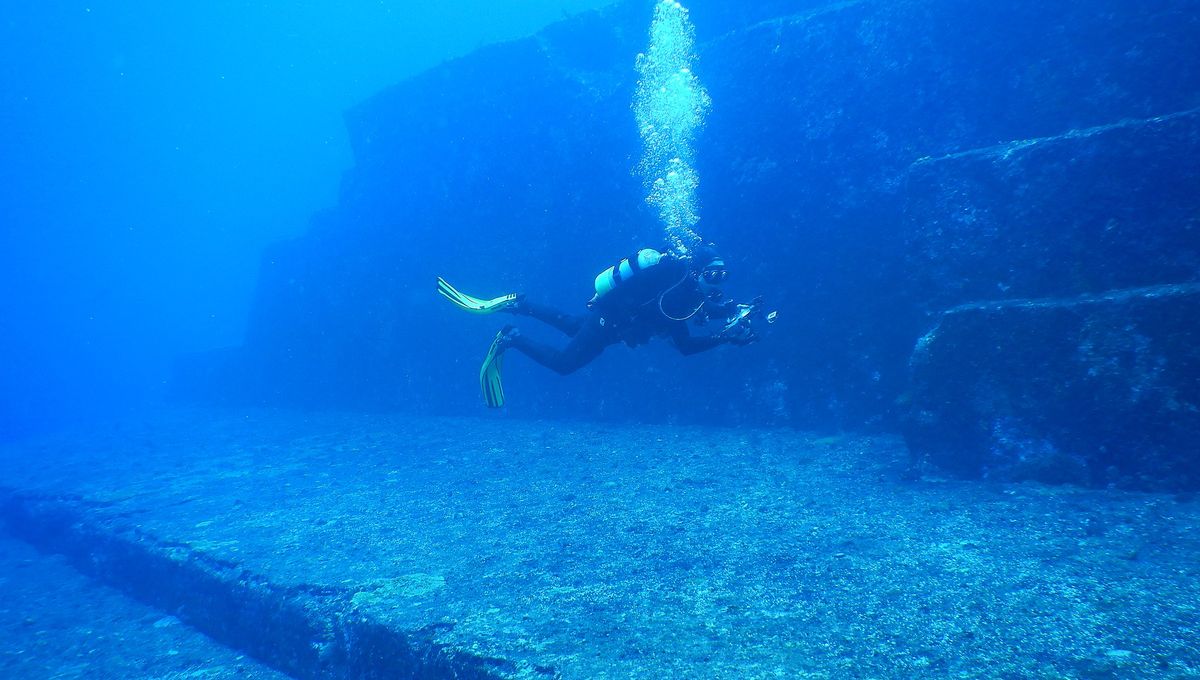
Around 100 kilometers (62 miles) east of Taiwan there is nothing but ocean, but look below the depths and there is a much stranger sight. Huge steps of stone apparently lead up a massive pyramid-like structure, the stone looking too shaped and uniform to be natural, while hammerhead sharks surround the curious area.
This is the Yonaguni monument, a towering underwater monolith popular with divers and ecologists for its peculiar features and incredible biodiversity. Over the years there have been plenty of ideas about what this monument is, from a giant human-made monolith to a natural ecological feature that happens to look like a pyramid. So, what is it?
What is the Yonaguni monument?
The Yonaguni monument sits at a depth of 25 meters (82 feet) below sea level, making it an ideal attraction for divers looking for diverse marine life. It’s no easy dive, though, as strong currents in the area make it a tricky swim for anyone except experienced visitors.
It was discovered in 1987 after Kihachiro Aratake went looking for a new and interesting site to take tourists to. As they approached the area, large stone formations rose in front of them, which Aratake believed to resemble human archaeological structures. Upon returning, Aratake called on scientists from the University of the Ryūkyūs to explore the area, and it was later named the Yonaguni monument.
Since its discovery, it has garnered huge interest in how the formations got there. Nicknamed by some as Japan’s “Atlantis”, the geometric shapes and smooth rock carvings of the monument resemble an ancient underwater city, leading many to question its origins.
Japan’s Atlantis or a fascinating rock?
Aratake believed that if the monument had not been carved by the sea gods themselves, it must be created by a human civilization at some point in history. Some claimed it was the legendary lost continent of Lemuria, a mythical continent that supposedly sunk beneath the Indian Ocean thousands of years ago.
One of the leading scientists that first visited the site dated the rocks to around 10,000 years ago, at which point they would have been above sea level. This scientist, named Masaaki Kimura, postulated that it could in fact be Lemuria (which was also called the continent of Mu), and claimed that he could pick out cultural buildings such as pyramids, castles, and a stadium within the monument; he later reduced his estimate to around 2,000-3,000 years old instead, but remained in his belief of artificial construction.
Since then, scientists have branded these claims as pseudoarchaeological, and since Atlantis doesn’t exist, it’s not that either. In an article called “An Enigmatic Ancient Underwater Structure off the Coast of Yonaguni Island, Japan”, Dr Robert Schoch, who holds a PhD in geology and geophysics, made the case that the monument is natural, noting a number of consistent features with nearby geological structures. It lies in an earthquake-prone region, and the fractures and flat faces that make up the stepped shape are typical of other sandstone formations.
This explanation was later built on by a number of experts in the field, due to both the appearance of the overall monument – when looking at the larger picture, it looks a lot more like a bizarre rock than an ancient city – and the timings when any possible ancient civilizations could have built it, if it was at all viable.
Essentially, due to when the sea levels would have risen above the monument, it would have had to have been built at least 12,000 years ago to be artificial, which predates any sophisticated civilization known to us (including the Göbekli Tepe) but is too complex for hunter/gatherers. If the Yonaguni monument is ever demonstrated as artificial, it would indicate a completely unknown, highly intelligent civilization that lived way before any others.
So, it’s probably just a big rock, which is much less fun to think about.
Source Link: What Is The Controversial Yonaguni Monument, Nicknamed "Japan's Atlantis"?